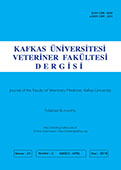
This journal is licensed under a Creative Commons Attribution-NonCommercial 4.0 International License
Kafkas Üniversitesi Veteriner Fakültesi Dergisi
2018 , Vol 24 , Issue 2
Molecular Characterization of Tick-Borne Blood Protozoa in Stray Dogs from Central Anatolia Region of Turkey with a High-Rate Hepatozoon Infection
1Department of Parasitology, Faculty of Veterinary Medicine, Ankara University, TR-06110 Diskapi, Ankara - TURKEY
DOI :
10.9775/kvfd.2017.18678
Tick-borne blood protozoa play an important role in canine health, especially, Babesia and Hepatozoon species. In dogs, these species
lead to clinical symptoms ranging from mild to severe. This study aimed to investigate the presence of tick-borne blood protozoa
in stray dogs using microscopy and molecular methods. While none of the blood smears showed any Babesia spp. piroplasms,
Hepatozoon spp. gametocytes were detected in 3.8% of examined samples. PCR analyses revealed the presence of a Hepatozoon
infection in 49.5% of dogs. However, the presence of Babesia spp. was not found in any dogs. Sequence and phylogenetic analyses
revealed that 86% of the positive cases were Hepatozoon canis and 13.7% were Hepatozoon sp. MF. The positivity rate obtained in
this study was higher than the reported rates in many regions in Turkey. This suggests that Hepatozoon infections present a risk
to dog health in this region. In addition, Hepatozoon sp. MF (a new genotype of undetermined pathogenicity) is reported in dogs
from this region and detailed pathogenicity and epidemiological studies are thus required for this genotype. This study, therefore,
suggests that H. canis is common in stray dogs in Ankara. Canine hepatozoonosis should be taken into consideration in pet clinics
and the differential diagnosis should not be overlooked.
Keywords :
Dog, Hepatozoon, Babesia, PCR, Molecular phylogeny










